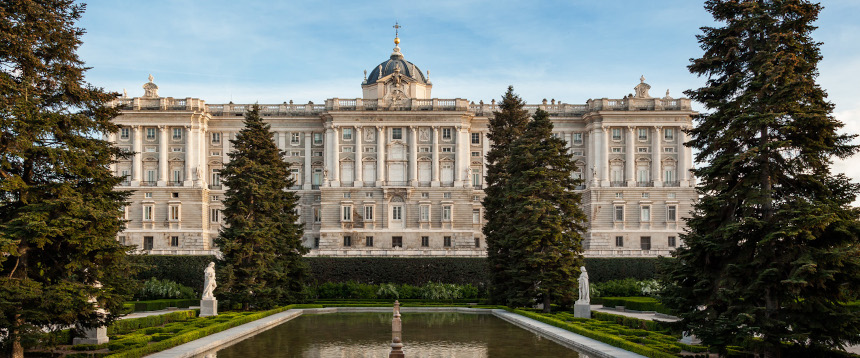Patrimonio Nacional is a public body regulated by a specific law of 1982, Law 23/1982, of 16 June, which inherited a long series of provisions which include the laws of 1865, 1869, 1876, 1932 and 1940, apart from the ordinances prior to the 19th century. In short, this state entity constitutes the essential and most important nucleus of the former Royal Heritage, or Crown Heritage, called Republican Heritage by the Law of 1932, and under its current name since the laws of 1940 and 1982.
This public body, which is under the Ministry of the Presidency, Relations with Parliament and Democratic Heritage, has a dual function: to support the Head of State in the role of high representative attributed by the Constitution and laws, and to make the historical-artistic heritage that it manages available to the public through its use for cultural, scientific and educational purposes.
It is important to highlight the unity of its assets, linked by a continuous process of creation, especially intense between the 16th and 19th centuries, which has given rise to ensembles where the movable pieces and works of art are linked to the buildings, and everything to the political and cultural history of Spain. The coherence of this ensemble, and the interrelationships between spaces, objects and memory that exist within it, give this Heritage its primary cultural and historical value.
The monarchs, as in the vast majority of the different European courts of the Modern Age, spent a lot of their time outside the capital. They would spend each part of the year in one of the Royal Sites around Madrid: spring in Aranjuez, summer in Valsaín and La Granja, autumn in El Escorial, winter in El Pardo and in Madrid. This city was the official seat of the court, but the truly powerful moved through all these settings to the rhythm of the seasons, where the forests and hunting grounds, parks and gardens, palaces, collections and town planning were all at their service.
The process of creating this heritage began at the dawn of the Middle Ages, arising from the establishment of the kingdoms that took shape across the Peninsula. There is a long list of palaces and religious buildings that were linked to the respective monarchy of each kingdom - the royal patronages, such as Las Huelgas - to proclaim the presence of dynasties in each of the territories that, through a long process of union, converged and took final shape in the Monarchy of Spain at the outset of the Modern Age. Some medieval palaces have survived,
either as convents - Tordesillas - or as royal seats in the respective capital city of each ancient kingdom - the Almudaina in Mallorca.
This medieval substrate was the basis for the definitive configuration of the Royal Sites under the Habsburgs and Bourbons, from the installation of the capital in Madrid by Philip II in 1561 and his foundation of El Escorial in 1563. The forests, gardens and crops, especially in Aranjuez, were perfected by Philip V, creator of La Granja de San Ildefonso, and by Ferdinand VI and Charles III, who made each Royal Site a small model city as they extended the palaces. The sublime ornamentation of the royal residences and collections reached its peak under Charles IV, with significant contributions in the 19th century.
The reign of Fernando VII and the end of the old regime saw a clear distinction made for the first time between the property of the state and this property linked to the Crown called Royal Heritage.
The institution "Patrimony of the Crown" was officially created in the reign of Isabel II in 1865, with the first law to regulate its existence. This new legal framework sought to adjust this collection of Crown properties to the new economic, political and social reality. It distinguished the properties linked to the Crown for the representation of power and for the daily life of the monarchs, which belong to the state and have to remain united, and the private possessions of the monarchs, which come from goods previously considered free, or from their civil list.
The Law of 1932 defended the unity of this group of properties and defined for the first time the double cultural and representative function of this "Patrimony of the Republic", a name that was transformed into "National" by the law of 1940, which essentially follows the pattern of the previous one. The use of the palaces for official representation by the Head of State took place both under the Second Republic and during Franco's dictatorship, while their cultural function was being developed.
Law 23/1982, of 16 June, on National Heritage, the law which regulates this body today, acknowledges the institution as the public body responsible for the assets owned by the State that have come from the legacy of the Spanish Crown, and to administrate the rights of the Royal Foundations and Patronages. Its main functions are to support the Head of State in the role of high representative attributed by the Constitution and laws and to make the historical-artistic heritage that it manages available to the public through its use for cultural, scientific and educational purposes.
The diverse nature of the assets and the compatibility between their different uses make the public service work Patrimonio Nacional carries out extensive and complex. This unique collection of historical properties is one of the most important among those of the ancient courts of Europe, and its current dual public function, cultural and representative, is the result of a long historical process, which makes Patrimonio Nacional a unique institution in the world.

